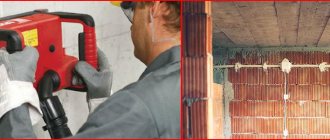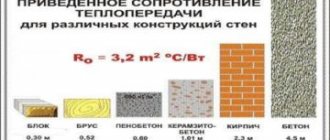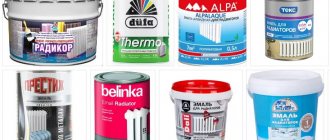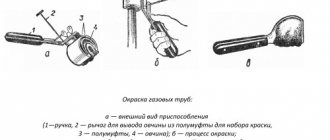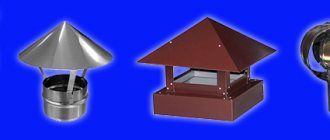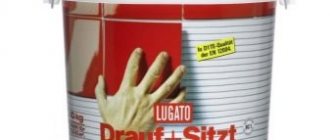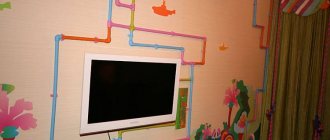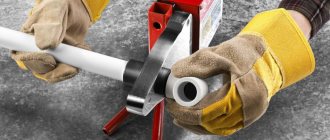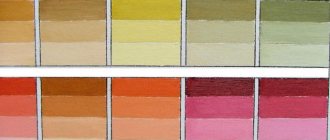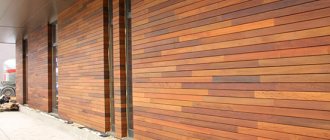The rapid pace of construction and the need to save money are increasingly making it necessary to lay electrical wiring in an open way. Where cable and wire products are exposed to negative environmental influences and mechanical damage. Therefore, in accordance with the requirements of clause 522.6.2 of GOST R 50571.5.52-2011, cable corrugation can be used as additional protection in electrical wiring. We will look at what it is used for and what design features it has in this article.
Purpose of cable corrugation
A corrugated hose can be called a hose made of plastic or other material with stiffening ribs.
It is used for purposes such as:
- increasing fire safety when working on flammable partitions;
- reducing the compression force (if the corrugation is used for laying cables in a concrete screed);
- prevention of mechanical damage to the cable;
- reducing the influence of harmful environmental factors on external electrical wiring;
- pulling several wires of the same or different sections into one hose, depending on the size of the corrugation;
- increased water resistance during underground installation;
- facilitating the re-laying of wires using special couplings at turns.
Installation
Now that you know why corrugation is needed in electrical wiring, it is worth considering the algorithm for the correct installation of corrugated hoses.
Corrugated pipes must be laid according to certain rules Source tehznatok.com
Thus, when laying cables and wires externally, special plastic clips and clamp-dowels are used for fastening, which are attached every 20-30 cm. In this case, ordinary dowels or self-tapping screws are used additionally, but in such a way as not to damage the integrity of the outer layer of the corrugation. If the installation is carried out in grooves, plastic ties (clamps) or tin strips secured in the middle with nails are also used.
To correctly install corrugated pipes with wiring, the following rules must be observed:
- absence of sharp turns, the angle of which is less than 90 ° (for a track with four turns, the length can reach a maximum of 25 meters);
- if low-current cables are located near the route being laid, a distance of at least 20 cm should be maintained;
- if the structure in which the wiring needs to be installed is monolithic, the corrugated hose must be placed before concrete is poured, and the wires should be pulled after the mortar has hardened;
- the distance between two adjacent turns of the electric corrugation is at least 4-5 meters;
Structural types of corrugation
Depending on the design features, corrugation is divided into 4 types.
Lightweight
This is the thinnest walled tube providing the greatest flexibility. It is best to use it on long winding sections, under gypsum fiber board or plywood sheathing. Due to its low strength, it does not protect the wire well from shock.
Medium density
Its rigidity is higher than that of the previous type of ribbed hose. It can be walled into walls. This type is less common than others, otherwise why would you need corrugation, which bends poorly and at the same time does not sufficiently protect against mechanical damage and concrete pressure. If the pipe collapses, it will be impossible to install a new cable into it.
Heavy
It has the greatest wall thickness and poor mobility. It is laid in open ground, in a concrete screed. To make turns, they buy additional fittings - corners, tees, couplings, etc. This corrugated pipe protects the cable from penetration of moisture and dirt.
Reinforced
The most tensile strength, because Inside it there is a steel wire mesh. It is best to use reinforced corrugation for installing a street or underground electrical network.
Briefly about the main thing
Cable corrugation is used to protect wires underground, indoors or outdoors.
Corrugated pipe can be synthetic, metal, or combined.
Thick corrugated pipes are used to protect wires from external destructive influences, thin ones protect from dust and help organize space.
Installation of corrugated hoses occurs in compliance with certain rules, using special fasteners. Some parameters of the corrugation used are fixed by official standards.
To correctly select the right type of corrugation for a wire, you must use a table that indicates the number and thickness of wires; you should also take into account some other important factors.
Ratings 0
Materials used to make cable corrugations
In the production of corrugated pipes, various types of raw materials are used.
The most common of them:
- High-density polyethylene (HDPE). The most flammable material among others, therefore laying wires in it inside flammable structures is not allowed. Installation must be carried out in concrete, walls made of bricks, foam blocks, etc. The advantage will be the wide range of temperatures that the pipe can withstand: -500…+900 °C.
- Polyvinyl chloride (PVC). Due to its self-extinguishing property, it does not support combustion and is a fireproof installation element. Suitable for creating electrical networks inside building structures, over ceilings and under floors, in wall grooves.
- Low-density polyethylene (HDPE). Universal corrugation, suitable in terms of characteristics for open and closed installation indoors and outdoors, in the ground.
- Metal. It is a steel or aluminum ribbed hose. Protects the cable from heat and mechanical damage. Recommended for outdoor installation.
Recommendations
To create durable and safe wiring, when selecting and installing electrical corrugated pipes, you should be guided by the following recommendations:
- Avoid creating sharp corners. There should be no more than 2-3 of them (with an angle of 90˚) per 20-25 m of working material.
- When installing a long network, solid pieces of corrugation should be connected to each other by transit boxes, installing them at the corners or places close to the middle of the solid pipe.
- In monolithic construction, when heavy series metal corrugation is used, it is laid before pouring, fixing it to the metal structures. Wiring is carried out after the walls have been formed and hardened.
Number of layers and resistance to external influences
Plastic sleeves can be single-layered of different thicknesses or double-layered, with an additional protective jacket.
The use of corrugated PVC hoses should not be allowed in places where aggressive substances are present:
- solvents;
- petroleum products;
- aldehydes, etc.
Such compounds almost always exist in the soil of large populated areas.
Therefore, for laying in the ground, it is better to use aluminum or HDPE corrugation.
Corrugation dimensions and diameter
Each type of hose for installing electrical wiring with a stiffener includes several samples with different cross-sections.
PVC corrugation
The diameters of polyvinyl chloride sleeves are given in the table:
| Internal, mm | External, mm |
| 16 | 10,7 |
| 20 | 14,1 |
| 25 | 18,3 |
| 32 | 24,5 |
| 40 | 31,5 |
| 50 | 39,6 |
The wall thickness varies from 5 mm to 15 mm.
PVC corrugation has a thickness of up to 15 mm.
Reinforced sleeve
Reinforced corrugated pipe for laying cables is sold in the following sections:
| External, mm | Internal, mm |
| 9,8 | 5,1 |
| 11 | 7,7 |
| 13,5 | 9,7 |
| 15,6 | 11,7 |
| 19 | 14,7 |
| 22 | 18 |
| 38 | 31,5 |
| 45 | 37,5 |
| 58 | 49,5 |
| 71,5 | 62,5 |
| 87,5 | 78 |
With or without probe
For convenient pulling of wires inside the corrugation, a steel wire is placed in it - a probe (broach).
The diameters of such a sleeve are presented in the table:
| Outside, mm | Inside, mm |
| 16 | 10,7 |
| 20 | 14,1 |
| 25 | 18,3 |
| 32 | 24,5 |
| 40 | 31,5 |
| 50 | 39,6 |
| 63 | 50,6 |
The dimensional error is ±0.4 mm.
How to choose the size of corrugated pipe
In most cases, corrugation is selected depending on the consumer to whom the line leads:
- to lighting devices – 13 mm;
- to switches and sockets – 20 mm;
- between the junction box and the electrical panel – 25 mm;
- from one electrical panel to another - 32 mm;
- in passages between floors, in walls - 40 mm.
Low-current alarm wires, antennas, internet, etc. require 25 mm.
In each case, it is advisable to provide a spare line in case of cable damage.
Video description
A life hack for marking a route is shown in this video:
- if it is impossible to make the required distance between the turns of the electrical route, a distribution board (box) and an inspection hatch should be installed instead;
- to install hidden wiring in the walls, grooves of the required depth are first hollowed out (it must correspond to the diameter of the corrugated pipe);
- between two adjacent corrugated hoses there should not be less than 20 cm; if intersection is necessary, a right angle should always be maintained.
It is important! To correctly and securely fasten the corrugation, you need to lean it against a special, pre-fixed clip and press until a characteristic click is heard.
Connections between two different pieces of corrugation are made using special couplings, turn signals or tees. If it is necessary to protect the wires from water, special plugs with small slots are put on the corrugation.
To install corrugations for electrical wiring with a broach, that is, in a closed way, you need:
- Measure and cut the required length of the corrugated sleeve and make sure that it is tensioned.
- Secure the broach so that it does not go deep into the pipe.
How to lay a wire in a corrugation
To pull one or more cables through a corrugated hose, you need to connect them into a bundle using electrical tape or a plastic tie. If there is no probe in the hose, pull a stiff steel wire through it.
Next, perform the following actions:
- Use pliers to bite off a small piece of the broach.
- Wind it in several places around the bundle of wires.
- Compress the twisted area with pliers so that you get a flat surface.
- Place the free end of the probe parallel to the harness.
- Connect them and wrap them tightly with electrical tape.
If it is necessary to pull through 1 cable, then its sheath is pierced with an awl, and a probe is passed through the hole. Then they bend it to form a hook, twist it and secure it with insulating tape.
Average cost of corrugated pipes for wiring
Prices for corrugation for laying wires are as follows:
- non-flammable PVC with broach and degree of protection IP 55 with a diameter of 16 mm – 9 rubles. for 1 m;
- self-extinguishing HDPE for use in grooves and outdoors with a cross-section of 16 mm – 15 rubles. for 1 m;
- PVC 25 mm for interior work in a bay of 50 m – 10 rub. for 1 m;
- PND-25 – 16 rub. for 1 m;
- PVC-32 – 18 rub. for 1 m, etc.
You can find out the cost of all types of hoses on the websites of manufacturers and sellers, as well as in stores and construction markets.
What to look for when purchasing
First of all, having already decided on the material of the corrugated pipe, you need to carefully study the letter markings and color.
So, for a metal hose, the presence of the letter “X” in the name means the presence of a cotton seal, “A” – asbestos-cement, “P” – additional polyvinyl chloride insulation.
In addition, steel hoses may have flanges and ends for welding at the ends, which is useful during installation.
The color of the corrugation will tell you about the purpose of the pipe, since the standard approves the matching colors of cables and pipes suitable for them.
| Color | Purpose |
| gray or black | general. |
| white | computer networks. |
| green | telephone lines. |
| red | external street laying. |
When routing cables, it is convenient to rely on color standards - all directions are immediately visible
But paying attention to color is also important for another reason - uneven color means poor quality of the pipe material
To simplify installation, manufacturers often supply corrugated hoses with a broach - a special bundle that simplifies pulling the cable through the channel. The price of such corrugation will be higher. Also, when purchasing, you should check the availability of the necessary accessories: clamps, clips, tape for installation.
